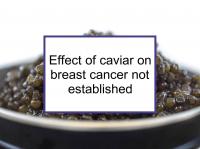Caviar is produced using the roe, or eggs, of fish. Authentic black caviar is made from sturgeon (including Beluga sturgeon) roe. Other fish such as salmon, lumpfish, trout, and carp are also used to make caviar (which is typically red or orange in color), but such caviar must be labeled indicating the roe source (e.g., salmon caviar).
Cancer-related effects of eating caviar
Caviar's high salt content linked to gastrointestinal cancers
To make caviar, the fish eggs are graded, sorted, salted and cured, which gives them a high sodium content. Frequent consumption of caviar or other salted fish roe products has been found to be associated with increased risks of gastric, colorectal and related cancers, presumably because of their elevated salt content. Data is unavailable concerning any possible association between caviar intake and breast cancer risk.
Caviar contains both favorable and unfavorable compounds
Caviar is an excellent source of choline, vitamin B12 and the marine omega-3 polyunsaturated fatty acids docosahexaenoic acid (DHA) and eicosapentaenoic acid (EPA), a very good source of selenium and pantothenic acid (vitamin B5), and also contains vitamin D, most of which have been associated with lower risk of breast cancer. However, caviar also has high levels of cholesterol, iron, and sodium, which may increase breast cancer risk.
For example, while iron deficiency anemia obviously is to be avoided (and is in fact associated with increased breast cancer risk), significantly elevated iron as a result of regularly consuming caviar and other iron-rich foods could be detrimental to some women. Relatively high levels of iron in benign breast tissue was found in one prospective study to be associated with increased risk of subsequent breast cancer.
Tumors are iron consumers. Breast cancer cells have abnormal pathways of iron acquisition, storage and regulation, suggesting that reprogramming of iron metabolism is an important aspect of cancer cell survival. Iron has been shown to facilitate cancer cell proliferation and growth. It is also an important contributor to tumor angiogenesis (the growth of new blood vessels).
The addition of iron to breast cancer cells and their microenvironment has been demonstrated to protect them from being killed by natural killer cells. At the same time, iron depletion has been shown to lead to significant inhibition of breast cancer cell growth in the laboratory.
In addition, excess iron has been shown to have the potential to interfere with the treatment effects of the chemotherapy drug doxorubicin.
Note that high salt intake can also increase the risk of heart damage from treatment with trastuzumab or anthracyclines such as doxorubicin.
Bottom line
The high salt, iron and cholesterol levels of caviar and other fish roe, as well as their association with digestive tract cancers, lead us to suggest that fatty fish such as herring, mackerel or salmon would be a better way to obtain the benefits of caviar's beneficial components (please see our fatty fish webpage for more information).
Additional comments
It can be difficult to obtain complete nutritional information for caviar purchased in specialty stores or online. There have been reports of unacceptably high levels of preservatives, coloring and other food additives in some brands of caviar. On the other hand, preservative-free caviar can more easily become contaminated with microorganisms. Caviars from some areas of the world have relatively high levels of carcinogenic polychlorinated biphenyls (PCBs) and other environmental pollutants. Buyers of caviar should be aware of its source and assure themselves of its safety and quality.
Canned caviar can also be a source of bisphenol A (BPA), a breast carcinogen that is often used in interior can coatings to prevent corrosion.
Note that while we are continually searching for new evidence specifically concerning this food, there is not much interest in it among breast cancer researchers, so few studies are available.
